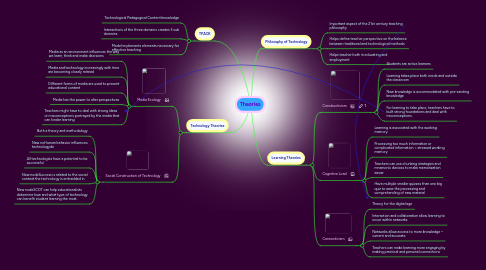
1. Technology Theories
1.1. Media Ecology
1.1.1. Media as an environment influences the way we learn, think and make decisions
1.1.2. Media and technology increasingly with time are becoming closely related
1.1.3. Different forms of media are used to present educational content
1.1.4. Media has the power to alter perspectives
1.1.5. Teachers might have to deal with strong ideas or misconceptions portrayed by the media that can hinder learning
1.2. Social Construction of Technology
1.2.1. Both a theory and methodology
1.2.2. New noHuman behavior influences technologyde
1.2.3. All technologies have a potential to be successful
1.2.4. New nodeSuccess is related to the social context the technology is embedded in
1.2.5. New nodeSCOT can help educationalists determine how and what type of technology can benefit student learning the most.
2. TPACK
2.1. Technological Pedagogical Content knowledge
2.2. Interactions of the three domains creates 3 sub domains
2.3. Model implements elements necessary for effective teaching
3. Learning Theories
3.1. Constructivism
3.1.1. Students are active learners
3.1.2. Learning takes place both inside and outside the classroom
3.1.3. New knowledge is accommodated with pre-existing knowledge
3.1.4. For learning to take place, teachers have to built strong foundations and deal with misconceptions.
3.2. Cognitive Load
3.2.1. Learning is associated with the working memory
3.2.2. Processing too much information or complicated information = stressed working memory
3.2.3. Teachers can use chunking strategies and mnemonic devices to make memorization easier
3.2.4. Have multiple smaller quizzes than one big quiz to ease the processing and comprehending of new material
3.3. Connectivism
3.3.1. Theory for the digital age
3.3.2. Interaction and collaboration allow learning to occur within networks
3.3.3. Networks allow access to more knowledge – current and accurate.
3.3.4. Teachers can make learning more engaging by making practical and personal connections
